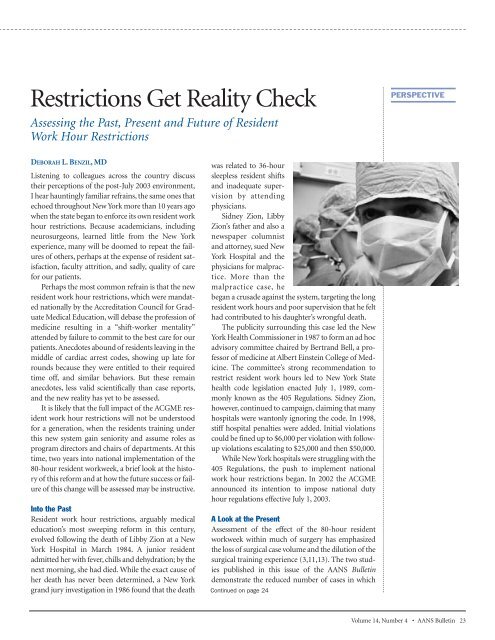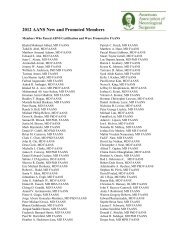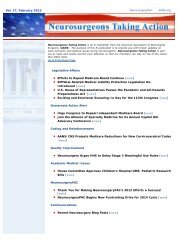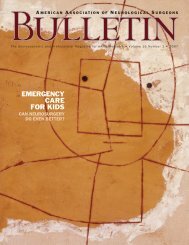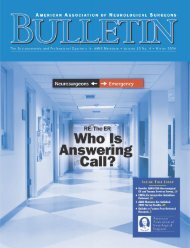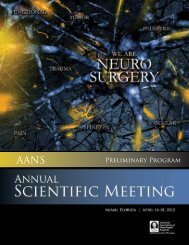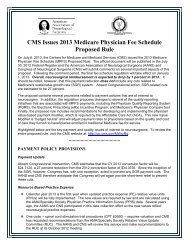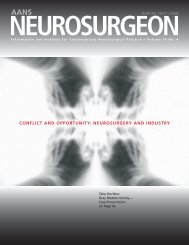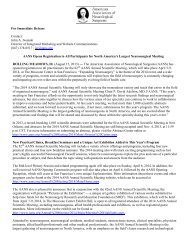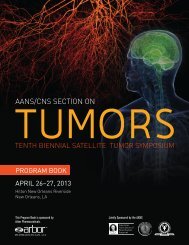view PDF - American Association of Neurological Surgeons
view PDF - American Association of Neurological Surgeons
view PDF - American Association of Neurological Surgeons
Create successful ePaper yourself
Turn your PDF publications into a flip-book with our unique Google optimized e-Paper software.
Restrictions Get Reality Check<br />
Assessing the Past, Present and Future <strong>of</strong> Resident<br />
Work Hour Restrictions<br />
PERSPECTIVE<br />
DEBORAH L. BENZIL,MD<br />
Listening to colleagues across the country discuss<br />
their perceptions <strong>of</strong> the post-July 2003 environment,<br />
I hear hauntingly familiar refrains, the same ones that<br />
echoed throughout New York more than 10 years ago<br />
when the state began to enforce its own resident work<br />
hour restrictions. Because academicians, including<br />
neurosurgeons, learned little from the New York<br />
experience, many will be doomed to repeat the failures<br />
<strong>of</strong> others, perhaps at the expense <strong>of</strong> resident satisfaction,<br />
faculty attrition, and sadly, quality <strong>of</strong> care<br />
for our patients.<br />
Perhaps the most common refrain is that the new<br />
resident work hour restrictions, which were mandated<br />
nationally by the Accreditation Council for Graduate<br />
Medical Education, will debase the pr<strong>of</strong>ession <strong>of</strong><br />
medicine resulting in a “shift-worker mentality”<br />
attended by failure to commit to the best care for our<br />
patients. Anecdotes abound <strong>of</strong> residents leaving in the<br />
middle <strong>of</strong> cardiac arrest codes, showing up late for<br />
rounds because they were entitled to their required<br />
time <strong>of</strong>f, and similar behaviors. But these remain<br />
anecdotes, less valid scientifically than case reports,<br />
and the new reality has yet to be assessed.<br />
It is likely that the full impact <strong>of</strong> the ACGME resident<br />
work hour restrictions will not be understood<br />
for a generation, when the residents training under<br />
this new system gain seniority and assume roles as<br />
program directors and chairs <strong>of</strong> departments. At this<br />
time, two years into national implementation <strong>of</strong> the<br />
80-hour resident workweek, a brief look at the history<br />
<strong>of</strong> this reform and at how the future success or failure<br />
<strong>of</strong> this change will be assessed may be instructive.<br />
Into the Past<br />
Resident work hour restrictions, arguably medical<br />
education’s most sweeping reform in this century,<br />
evolved following the death <strong>of</strong> Libby Zion at a New<br />
York Hospital in March 1984. A junior resident<br />
admitted her with fever, chills and dehydration; by the<br />
next morning, she had died. While the exact cause <strong>of</strong><br />
her death has never been determined, a New York<br />
grand jury investigation in 1986 found that the death<br />
was related to 36-hour<br />
sleepless resident shifts<br />
and inadequate supervision<br />
by attending<br />
physicians.<br />
Sidney Zion, Libby<br />
Zion’s father and also a<br />
newspaper columnist<br />
and attorney, sued New<br />
York Hospital and the<br />
physicians for malpractice.<br />
More than the<br />
malpractice case, he<br />
began a crusade against the system, targeting the long<br />
resident work hours and poor supervision that he felt<br />
had contributed to his daughter’s wrongful death.<br />
The publicity surrounding this case led the New<br />
York Health Commissioner in 1987 to form an ad hoc<br />
advisory committee chaired by Bertrand Bell, a pr<strong>of</strong>essor<br />
<strong>of</strong> medicine at Albert Einstein College <strong>of</strong> Medicine.<br />
The committee’s strong recommendation to<br />
restrict resident work hours led to New York State<br />
health code legislation enacted July 1, 1989, commonly<br />
known as the 405 Regulations. Sidney Zion,<br />
however, continued to campaign, claiming that many<br />
hospitals were wantonly ignoring the code. In 1998,<br />
stiff hospital penalties were added. Initial violations<br />
could be fined up to $6,000 per violation with followup<br />
violations escalating to $25,000 and then $50,000.<br />
While New York hospitals were struggling with the<br />
405 Regulations, the push to implement national<br />
work hour restrictions began. In 2002 the ACGME<br />
announced its intention to impose national duty<br />
hour regulations effective July 1, 2003.<br />
A Look at the Present<br />
Assessment <strong>of</strong> the effect <strong>of</strong> the 80-hour resident<br />
workweek within much <strong>of</strong> surgery has emphasized<br />
the loss <strong>of</strong> surgical case volume and the dilution <strong>of</strong> the<br />
surgical training experience (3,11,13). The two studies<br />
published in this issue <strong>of</strong> the AANS Bulletin<br />
demonstrate the reduced number <strong>of</strong> cases in which<br />
Continued on page 24<br />
Volume 14, Number 4 • AANS Bulletin 23


